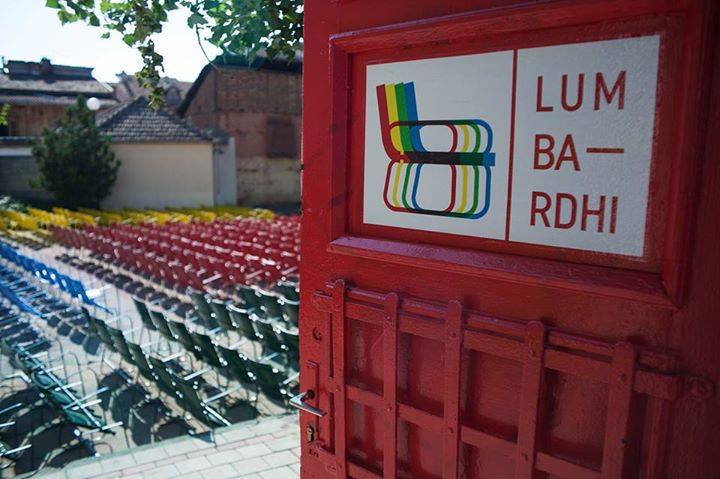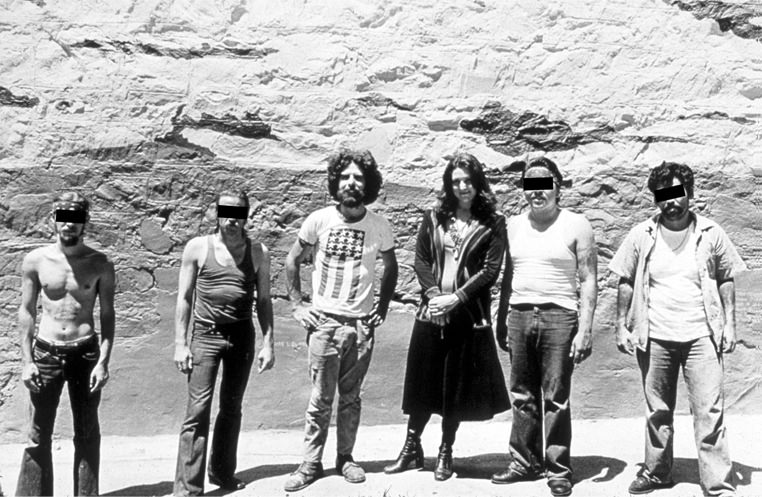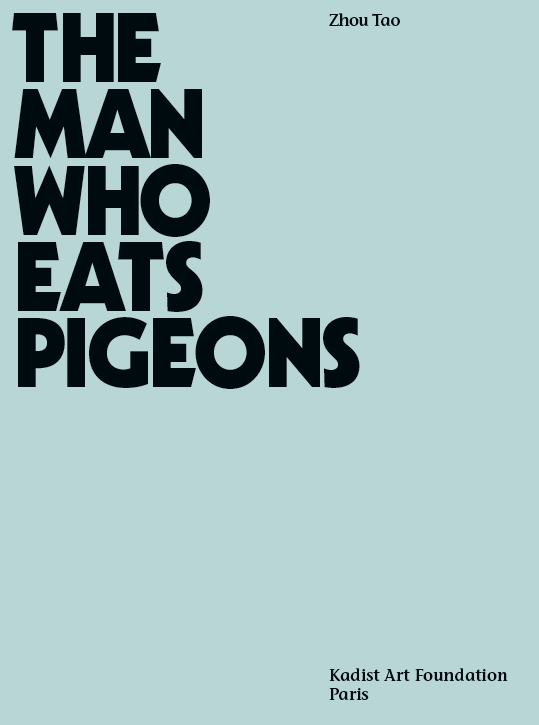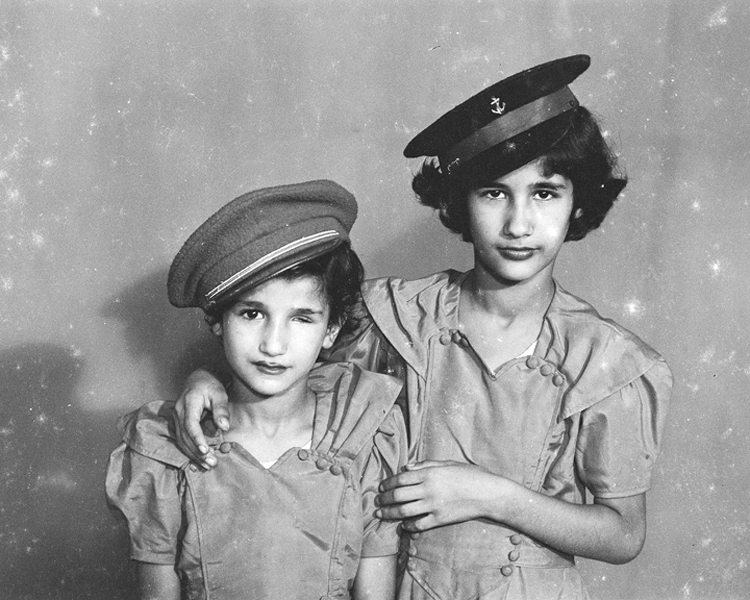
© » KADIST
Carolyn Drake
Megan and Hazel Sue at Creekmore House by Carolyn Drake is from a series of works titled Knit Club . For this project, Drake collaborated with an enigmatic group of women in Mississippi who loosely call themselves “Knit Club”. The subject matter of this photograph centers on the relationship between the girl and doll in the painting, and the woman and girl in the photograph.

© » KADIST
Kelly Sinnapah Mary
Notebook 10 , l ‘enfance de sanbras (The Childhood of Sanbras) series by Kelly Sinnapah Mary is a sequel to an earlier series by the artist titled Cahier d’un non retour au pays natal (2015). This earlier work considers the process of reconstructing an identity of the Indian workers who arrived in the Caribbean during the post-slavery period. The work addresses the conditions of recruitment of these Indian workers, the strategies of the recruiters, how they lured them onto ships to bring them back to the plantations.

© » KADIST
Bady Dalloul
With Inner Child , Bady Dalloul continues his ongoing reflection on migration and belonging, putting in balance levantine and Japanese histories. The most recent in a series of works gathering images and sounds from the different countries the artist lived or worked in, this video is part of a multi-channel sound installation that aims to transport us into a meditative state. To do so, the artist worked with Mami Nakanishi, a trained hypnotherapist, to write a script that could reflect an internal and multilinguistic dialogue that alternates between Arabic, English, French, and Japanese.

© » KADIST
Gan Chin Lee
Drawing & Print (Drawing & Print)
In Studies of Chinese New Villages II Gan Chin Lee’s realism appears in the format of a fieldwork notebook; capturing present-day surroundings while unpacking their historical memory. The watercolor images on each note paper document the artist’s visits to various Chinese ‘New Villages’ in Malaysia. The studies, some in color and others in grey-scale, from this series include architectural ruins, portraits of people and animals, and groups of people in protest.

© » KADIST
Gan Chin Lee
Drawing & Print (Drawing & Print)
In Studies of Chinese New Villages II Gan Chin Lee’s realism appears in the format of a fieldwork notebook; capturing present-day surroundings while unpacking their historical memory. The watercolor images on each note paper document the artist’s visits to various Chinese ‘New Villages’ in Malaysia. The studies, some in color and others in grey-scale, from this series include architectural ruins, portraits of people and animals, and groups of people in protest.

© » KADIST
Gan Chin Lee
Drawing & Print (Drawing & Print)
In Studies of Chinese New Villages II Gan Chin Lee’s realism appears in the format of a fieldwork notebook; capturing present-day surroundings while unpacking their historical memory. The watercolor images on each note paper document the artist’s visits to various Chinese ‘New Villages’ in Malaysia. The studies, some in color and others in grey-scale, from this series include architectural ruins, portraits of people and animals, and groups of people in protest.

© » KADIST
Bakudapan Food Study Group
Mooi indie (which translates to “Beautiful Indies”) is a term used to depict the beauty of nature in the East Indies during the period of Dutch colonialism in Indonesia. The term is usually used to describe a painting, romanticising the alluring tropics through the lens of European imperialism. Later in the 1950s, the prominent Indonesian painter S. Sudjojono, who is known as one of the founding fathers of Indonesian Modern Art, publicly rejected the Mooi Indie genre as Indonesian art.
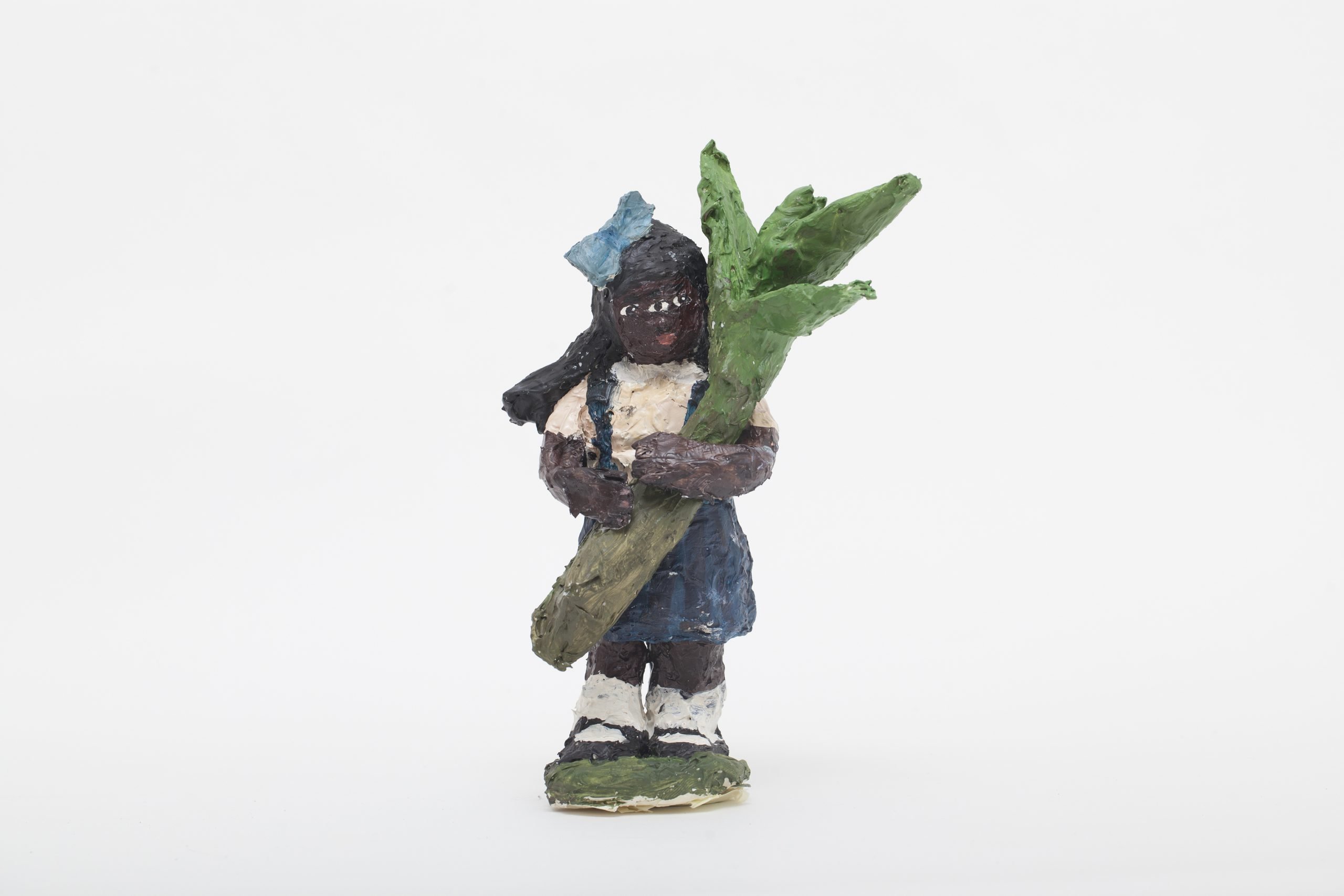
© » KADIST
Kelly Sinnapah Mary
Notebook 10 , l ‘enfance de sanbras (The Childhood of Sanbras) series by Kelly Sinnapah Mary is a sequel to an earlier series by the artist titled Cahier d’un non retour au pays natal (2015). This earlier work considers the process of reconstructing an identity of the Indian workers who arrived in the Caribbean during the post-slavery period. The work addresses the conditions of recruitment of these Indian workers, the strategies of the recruiters, how they lured them onto ships to bring them back to the plantations.

© » KADIST
Kelly Sinnapah Mary
Notebook 10 , l ‘enfance de sanbras (The Childhood of Sanbras) series by Kelly Sinnapah Mary is a sequel to an earlier series by the artist titled Cahier d’un non retour au pays natal (2015). This earlier work considers the process of reconstructing an identity of the Indian workers who arrived in the Caribbean during the post-slavery period. The work addresses the conditions of recruitment of these Indian workers, the strategies of the recruiters, how they lured them onto ships to bring them back to the plantations.

© » KADIST
Gan Chin Lee
Drawing & Print (Drawing & Print)
In Studies of Chinese New Villages II Gan Chin Lee’s realism appears in the format of a fieldwork notebook; capturing present-day surroundings while unpacking their historical memory. The watercolor images on each note paper document the artist’s visits to various Chinese ‘New Villages’ in Malaysia. The studies, some in color and others in grey-scale, from this series include architectural ruins, portraits of people and animals, and groups of people in protest.

© » KADIST
Felipe Romero Beltrán
Dialect by Felipe Romero Beltrán is a photographic series that follows a group of immigrants who have recently crossed the strait (the maritime border between Morocco and Spain) to avoid border controls. The young immigrants settle in Seville while their legal situation is either resolved or refused. Reflecting on his own status as a migrant, Beltra?n’s series of photographs documenting Morrocan immigrants is a tribute to their trajectories; a trace of their existences.

© » KADIST
Kelly Sinnapah Mary
Notebook 10 , l ‘enfance de sanbras (The Childhood of Sanbras) series by Kelly Sinnapah Mary is a sequel to an earlier series by the artist titled Cahier d’un non retour au pays natal (2015). This earlier work considers the process of reconstructing an identity of the Indian workers who arrived in the Caribbean during the post-slavery period. The work addresses the conditions of recruitment of these Indian workers, the strategies of the recruiters, how they lured them onto ships to bring them back to the plantations.

© » KADIST
Lungiswa Gqunta
Feet Under Fire by Lungiswa Gqunta depicts the artist’s lower legs swinging in and out of frame, above a bed of charcoal. She wears a pleated white dress, two identical white anklets, and a set of bristle brushes as shoes. Affixed to the base of each scrubbing brush is a black strap so that the brushes don’t fall off of her feet.

© » KADIST
Jeamin Cha
In On Guard by Jeamin Cha, a security guard receives safety training, juxtaposed against his patrol of an empty building as he tries to give care instructions for his ailing mother over the phone. The film dismantles the binary oppositions between “caring” and “guarding,” two actions that parallel one another in their emphasis on attentiveness without a logical conclusion. Cha’s exploration of the relationship between these two focuses is channeled through nocturnal urban space, drawing attention to the labor that each requires.

© » KADIST
Minia Biabiany
Qui vivra verra, Qui mourra saura is an installation by Minia Biabiany composed of the plan of a house made out of strips of salt, and a “garden” made of ceramic pieces, hanging from the ceiling and on the floor, and non woven fabric. She uses blue and red filters to alter the hues of light coming from the outside. The work focuses on the disappearance of traditional knowledge associated with the “jardin de case” outside Guadeloupean houses.

© » KADIST
Yuyan Wang
The Moon Also Rises by Yuyan Wang comprises a one-channel video and light installation. The work is based on a 2018 initiative in China to launch three artificial moons into orbit above major cities to provide continuous daylight. Set in an oppressively illuminated environment, the images depict lethargic crowds in megacities, surrounded by glowing neon lights, and workers in LED factories performing repetitive tasks on an assembly line in a kind of trance state.

© » KADIST
Sarah Navqi
A “mata ni pachedi” is a piece of painted textile that depicts narrative images of goddesses. Traditionally, the images would be painted onto a piece of cloth found in the temple. Also known as the “kalamkari” (a hand-painted or block-printed cotton textile), “mata ni pachedi” literally translates to “behind the mother goddess”.

© » KADIST
Sabelo Mlangeni
The Royal House of Allure is a name of a safe house on mainland Lagos where members of the queer community in need of boarding, due to various circumstances, live together. These houses are more than just places of survival; they are a physical embodiment of radical queer expression that encourage solidarity. The Royal House of Allure was initially conceived following an investigation of how social media influences celebrity culture.

© » KADIST
Mounira Al Solh
In 2011, Mounira Al Solh began a series of drawings that documented her meetings and conversations with displaced Syrian refugees in Lebanon and various European countries. The oral histories she collected are very different from those told in administrative interviews or police interviews. My specialty was to make a peasants’ haircut, but they obliged me work till midnight often (2017) is part of a series of embroideries that speaks to how personal stories in this political context create collective history.

© » KADIST
Karan Shrestha
After the decade-long conflict (1996-2006) that ended with Nepal becoming a Federal Democratic Republic, political unrest and weak governance continued to mark the country’s future as daily life repeatedly witnessed ruptures. From accessing essentials to employment, education, compensation, legal justice, health facilities, and human rights, the people of Nepal have been forced to wait. Meanwhile by Karan Shrestha records moments of impasse as the post-conflict period dragged on.

© » KADIST
Liu Yu
“Ship of Fools” is a literary term derived from Sebastian Brant’s 1949 satirical allegory of the same name. The work tells the story of a wandering vessel with 111 fools aboard; each of whom represents a social issue. The Ship of Fools Mooring at the Train Station is a two-channel video work by artist Liu Yu, concerning the community of people residing on the fringes of society at Taipei Main Station.

© » KADIST
Marcel Pardo Ariza
In Linda, Lee & Dorsey, Louis (1988~, 2018) Marcel Pardo Ariza draws on Bay Area queer histories that have been uncovered from local archives and queer organizations, and connects them to people currently living in the Bay, where Ariza is also based. This particular portrait features a skein of arms and legs, in both color and black and white print, intimately woven together. Tender and sensual, the tangle of limbs incorporates both stereotypically feminine and masculine traits in various skin tones.

© » KADIST
Lenka Clayton and Phillip Andrew Lewis
Five Hundred Twenty-Four, a single-channel video installation by Lenka Clayton and Phillip Andrew Lewis, features singers from over twenty Cleveland-area choirs counting numbers in an iterative process: one person sings “one”, then two people sing “two”, and so forth, to 524. Each choir was filmed separately, and the artists weave together the audio while the video features each choir individually. The juxtaposition of different contexts in which singing occurs functions as an embedded sociological study of various communities throughout the region.

© » KADIST
María Buenaventura
The Territory is not for sale is a process of reflection and research with people, thinkers and community leaders from Usme, a rural part of Bogotá on the tenuous verge of becoming urban. As an art object and installation, it comprises multiple stacks of paper each containing the decrees of land expropriation from many different peasant farmers who are being forced to sell their lots of land back to the government. Usme lies at the southern urban-rural border strategically located next to the Páramo de Sumapaz, an enormous neo-tropical tundra ecosystem and water reserve.

© » KADIST
Sabelo Mlangeni
The Royal House of Allure is a name of a safe house on mainland Lagos where members of the queer community in need of boarding, due to various circumstances, live together. These houses are more than just places of survival; they are a physical embodiment of radical queer expression that encourage solidarity. The Royal House of Allure was initially conceived following an investigation of how social media influences celebrity culture.

© » KADIST
Nguyen Trinh Thi
The essay film How to Improve the World by Nguyen Trinh Thi takes us into an indigenous village of the Jrai people in the Central Highlands of Vietnam, in Gia Lai province. It begins with sound – perhaps a hammer, or a gong – the lack of image making its identification difficult. A landscape emerges of an open field where a farmer tends his grazing cow herd.

© » KADIST
Sabelo Mlangeni
The Royal House of Allure is a name of a safe house on mainland Lagos where members of the queer community in need of boarding, due to various circumstances, live together. These houses are more than just places of survival; they are a physical embodiment of radical queer expression that encourage solidarity. The Royal House of Allure was initially conceived following an investigation of how social media influences celebrity culture.

© » KADIST
D’Angelo Lovell Williams
On January 7th, 2020, artist D’Angelo Lovell Williams was diagnosed with HIV. Only a handful of chosen family members knew up until the public announcement that coincided with the release of this body of work. According to the artist, “discovery” is key to this group of large photographs.

© » KADIST
Zai Kuning
Drawing & Print (Drawing & Print)
Converting is a piece about the Orang Laut, often called Sea Nomads, that inhabited the Riau archipelago. They were Christians and pagans that were often oppressed by the majority Muslims in the Riau community and were eventually forced to convert to Islam. Zai conveyed this history in Converting through the stark contrasts of red, white, black.

© » KADIST
Christian Nyampeta
The film Sometimes It Was Beautiful by Christian Nyampeta poetically addresses the systemic conditions leading and emerging from the 1994 Rwandan genocide, which had lasting and profound effects on Rwanda and neighbouring countries like Congo. The divergent opinions of the characters, as well as suggestive gestures, settings, and marks inscribed in the landscape highlight the different approaches in addressing the slow violence linked to the enduring impact of colonialism and imperialism, the pursuit of knowledge, and the conservation of heritage, culture, and object repatriation. Structured into six chapters, the film imagines a meeting between improbable friends and interlaces dialogues, with choreography of dancers, places and objects.
Gan Chin Lee
Gan Chin Lee is a Malaysian artist of Chinese descent known across Southeast Asia for his realist paintings that painstakingly register the ethnic and religious complexities of Malaysia...
Kelly Sinnapah Mary
Kelly Sinnapah Mary is a multidisciplinary artist who’s work is informed by the diasporic journey of her ancestors...
Sabelo Mlangeni
Photographer Sabelo Mlangeni’s black and white images capture the intimate, everyday moments of communities in contemporary South Africa...
Sheroanawe Hakihiiwe
Sheroanawe Hakihiiwe is a Yanomami artist who lives and works in Upper Orinoco, at the Venezuelan side of the Amazon rainforest...
Julian Abraham
Julian Abraham “Togar” is an artist, musician, and pseudo-scientist...
Jeamin Cha
Jeamin Cha’s questions exist in the gyre between individual and social environment, stepping over conspicuous strands of relation between the two in favor of cultivating characters that dwell in the night, under-noticed or otherwise surplus figures outside of mainstream societal representation...
Carolyn Drake
Carolyn Drake works on long term photo-based projects that involve travel and collaboration...
Lieko Shiga
Based on an instinctive feeling of unease with the convenience and automation of daily life, Lieko Shiga has developed an artistic approach that links questions about the nature of the photographic medium with fundamental questions about life and the means of expressing oneself...
Marwan Rechmaoui
- location: Bayrut, Al-Lubnan
- year born: 1964
- gender: male
- nationality: Lebanese
Liu Yu
Liu Yu has developed a multifaceted artistic practice that takes field documentation as its point of departure...
Lenka Clayton and Phillip Andrew Lewis
Lenka Clayton and Phillip Andrew Lewis’s collaborative practice is social at its core: it engages with and connects communities outside of the so-called art world in both production and presentation...
Sarah Navqi
Sarah Naqvi works with art-focused activism and material realities...
Emmanuel van der Auwera
Emmanuel van der Auwera is interested in conspiracy theories, surveillance photography and its ubiquity, giving texture to major events that are frequently smoothed out by media reporting...
Danielle Dean
Danielle Dean creates videos that use appropriated language from archives of advertisements, political speeches, newscasts, and pop culture to create dialogues to investigate capitalism, post-colonialism, and patriarchy...
Helina Metaferia
Helina Metaferia is an interdisciplinary artist working across collage, assemblage, video, performance, and social engagement...
Edie Fake
Edie Fake’s paintings start as self-portraits, referencing elements of the trans and non-binary body through pattern, color and architectural metaphor...
Mercedes Dorame
Mercedes Dorame is a photographer and member of the Tongva tribe in Los Angeles...
Soufiane Ababri
Soufiane Ababri’s practice is, first and foremost, embodied by the artist’s queer subjectivity...
Jeremy Deller
- location: London, United Kingdom
- year born: 1966
- gender: male
- nationality: British
Sharon Lockhart
- year born: 1964
- gender: female
- nationality: American
- home town: Norwood, Massachusetts
Amalia Pica
- location: London, United Kingdom
- year born: 1978
- gender: female
- nationality: Argentine
- home town: Neuquén, Argentina
Jarrett Key
Jarrett Key’s work addresses their concerns about the state of their freedom in America...
Zai Kuning
- year born: 1964
- gender: male
- nationality: Singaporean
- home town: Singapore
Bady Dalloul
Bady Dalloul cunningly employs collage across various media: texts, drawings, video, and objects to produce powerful works commenting on the past and the present...
Natsuko Uchino
Natsuko Uchino is an artist whose practice is defined by its interaction with agriculture and craft; she relocated to a rural area of France in order to have an open air studio where she could produce ceramics and work with natural elements such as mushrooms and fermentation techniques and where she collaborates with farms...
Lungiswa Gqunta
Lungiswa Gqunta’s practice addresses issues concerning South African post-colonial culture and the country’s contemporary political landscape...
Anne Samat
An exuberant and precise sculptor, Anne Samat blends the aesthetic of international queer cultures – which she proudly represents as a transgender activist – with various textile and bricolage influences from South East Asia and beyond...
Chemi Rosado-Seijo
Chemi Rosado-Seijo’s work consists of community-based interventions linked to the site where they have been developed...
Angelica Mesiti
Splitting her time between Sydney and Paris, Angelica Mesiti is a video, performance, and installation artist of Italian origin...
Polina Kanis
Polina Kanis (b...

© » KADIST
about 3 months ago (02/12/2024)
The KADIST mobile app features an art news section that compiles content from global sources covering contemporary art...
-
1950-1959
-
1960-1969
Lisetta Carmi
1969On New Year’s Eve in 1965, Lisette Carmi met and photographed a group of transgender people living and working on the Via del Campo in Genoa–the main street for prostitution in the city, located in the former Jewish ghetto...
-
1980-1989
Paz Errázuriz
1986La manzana de Adán (La Palmera, Santiago) by Paz Errázuriz is part of the celebrated series La manzana de Adán (Adam’s apple) that spans 5 years (1982-1987) of documenting the lives of transgender sex workers in La Jaula and La Palmera brothels in the Chilean cities of Talca and Santiago...
-
1990-1999
Santu Mofokeng
1990Mofokeng’s experiences during the turbulent time of the 1980s in South Africa led to a turn in his practice, opting to turn to the crowd, focusing on individual faces and bodies within the masses to tell a story of the collective resistance that is present in the daily life and surroundings of South African townships...
-
2000-2009
Heman Chong
2009With a habit of reading eight to ten books at the same time, Chong paints his two-foot tall novel covers through referencing an extensive reading list (accessible on Facebook) he has kept since 2006...
Luis Garciga
2009In Destinos Posibles Garciga performs a service in Havana, Cuba by offering strangers in the streets a “ride” to wherever they are going for free, in exchange he demands that the passengers address the question “what do they want from life?” A poignant video within the context of the limitations the Cubans have in terms of choices, desires, fantasies, and longing....
Szabolcs Kisspál
2009Lifesize Draft is the second of two sculptures on a similar theme, the first one being Utopia Battery, (2008)...
-
2010-2019
María Buenaventura
2011The Territory is not for sale is a process of reflection and research with people, thinkers and community leaders from Usme, a rural part of Bogotá on the tenuous verge of becoming urban...
Polina Kanis
2011In the seminal video Workout , Kanis looks at the phenomenon of exercise in public space—specifically aerobics exercises in parks around Moscow today—as a broader lens for thinking about generational change...
Sharon Lockhart
2011Visalia Livestock Market, Visalia, California results from Lockhart’s prolonged investigation of an agricultural center and community...
Jeremy Deller
2012Beyond the White Walls , with a commentary written and spoken by Jeremy Deller, is often wryly amusing...
Oded Hirsch
2012Oded Hirsch’s video work Nothing New (2012) utilizes seemingly absurdist tropes to raise more trenchant questions about communal action and collective identity in modern day Israel...
Angelica Mesiti
2013Angelica Mesiti’s piece, The Calling (2013-14) is a poignant exploration of ancient human traditions evolving and adapting to the modern world...
Amalia Pica
2013Memorial for intersections #2 (2013) is a minimalist, black metallic structure that contains the brightly colored translucent circles, triangles, rectangles, and squares that originally were presented in Pica’s performance work A ? B ? C (2013)...
Mohamed Bourouissa
2013After seeing Martha Camarillo’s photographs of horsemen in Strawberry Mansion -an impoverished Philadelphia neighbourhood- Mohamed Bourouissa travelled to see the urban stables run by African American men...
Zai Kuning
Drawing & Print
2014(Drawing & Print) Converting is a piece about the Orang Laut, often called Sea Nomads, that inhabited the Riau archipelago...
Khvay Samnang
2014The video Rubber Man continues exploring issues related to land use, also noticeable in his Untitled series (2011)...
Amor Muñoz
2014Yuca_tech: Energy by Hand is an installation by Amor Muñoz that resulted from a local technology lab in a small village in the Yucatán henequen zone, in the Mayan region of Mexico...
Vivek Vilasini
2014In his work Housing Dreams Walls , the houses photographed are from a closely-knit locale in Kerala – a significant and rapidly popular pattern in this part of the country...
Josh Faught
2014Some of Faught’s works have been inspired by the ad hoc monuments created at gravesites in San Francisco’s Neptune Society Columbarium, where many victims of the AIDS epidemic were laid to rest...
Jesús ‘Bubu’ Negrón
Drawing & Print
2015(Drawing & Print) The series of drawings Cancha Abierta (Yellow Series) derive from a project in which Jesús ‘Bubu’ Negrón worked with the community of El Rosario, located in the region of Beni, Bolivia, approximately 500 meters away from the Mamoré River...
Bontaro Dokuyama
2015In Over There, Bontaro Dokuyama conducted a series of workshops with various people who had been forced to relocate in temporary housing after the Fukushima accident...
Edie Fake
Drawing & Print
2015(Drawing & Print) Related to Edie Fake’s Memory Palaces series — reimagined facades of urban lesbian bars and gay nightclubs — Personal Business draws an association between architecture and the body, with ornamental structures that are decorative and protective...
Lola Gonzàlez
2015In Summer Camp , Lola Gonzàlez filmed a group of friends at the home of her parents in the department of Charente (France) in the process of transforming the house into a training camp...
Marcel Pardo Ariza
2016In Linda, Lee & Dorsey, Louis (1988~, 2018) Marcel Pardo Ariza draws on Bay Area queer histories that have been uncovered from local archives and queer organizations, and connects them to people currently living in the Bay, where Ariza is also based...
Eddie Arroyo
20165901 NW 2nd Ave., Miami, FL 33127 (Botanica) is a series of paintings that artist Eddie Arroyo created over an extended period of time, depicting the same site as it appeared from 2016 to 2018...
Chemi Rosado-Seijo
2016Map of the Universe from El Cerro continues Chemi Rosado-Seijo’s long-term engagement with the community of El Cerro , a rural, working-class community living in the mountains of Naranjito, Puerto Rico...
Mounira Al Solh
2017In 2011, Mounira Al Solh began a series of drawings that documented her meetings and conversations with displaced Syrian refugees in Lebanon and various European countries...
Karan Shrestha
2017After the decade-long conflict (1996-2006) that ended with Nepal becoming a Federal Democratic Republic, political unrest and weak governance continued to mark the country’s future as daily life repeatedly witnessed ruptures...
Lungiswa Gqunta
2017Feet Under Fire by Lungiswa Gqunta depicts the artist’s lower legs swinging in and out of frame, above a bed of charcoal...
Chikako Yamashiro
2017The film installation Mud Man by Chikako Yamashiro is set on Okinawa and South Korea’s Jeju Islands, two locations at the center of local controversies surrounding the presence of the United States military...
Danielle Dean
2017In True Red Ruin (Elmina Castle) , Danielle Dean uses archival documents to re-imagine colonial history from the 1400s, while also referencing her own personal history...
Bakudapan Food Study Group
2018Mooi indie (which translates to “Beautiful Indies”) is a term used to depict the beauty of nature in the East Indies during the period of Dutch colonialism in Indonesia...
Carolyn Drake
2018Megan and Hazel Sue at Creekmore House by Carolyn Drake is from a series of works titled Knit Club ...
D’Angelo Lovell Williams
2018On January 7th, 2020, artist D’Angelo Lovell Williams was diagnosed with HIV...
Christian Nyampeta
2018The film Sometimes It Was Beautiful by Christian Nyampeta poetically addresses the systemic conditions leading and emerging from the 1994 Rwandan genocide, which had lasting and profound effects on Rwanda and neighbouring countries like Congo...
Jeamin Cha
2018In On Guard by Jeamin Cha, a security guard receives safety training, juxtaposed against his patrol of an empty building as he tries to give care instructions for his ailing mother over the phone...
Mercedes Dorame
2018Mercedes Dorame utilizes photography to investigate, recode, and connect with her Gabrielino-Tongva tribe culture, as well as to bring current Indigenous experiences to light...
Jeamin Cha
2018Almost One by Jeamin Cha dives into an uncomfortable meditation on the relationship between socialization, performativity, truth, and childhood, filtered through the optics of a children’s acting class in South Korea...
Che Onejoon
2018Che Onejoon’s unsettling video My Utopia opens with a round table of women asking and answering the questions “Who am I? Where did I come from? Where should I go?” One of the women featured is Monique Macías, the daughter of Francisco Macías Nguema, the first Prime Minister of Equatorial Guinea...
Anne Samat
2018Anne Samat’s Puteri 3 references Ulek Mayang, a classical Malay dance, performed in a ritualistic pre-Islamic context...
Laura Henno
2018N°001 Djoubi et sa meute is part of a series of photographs by Laura Henno titled Ge Ouryao! ...
Francisca Benítez
2018You have given the world your songs by Francisca Benítez is a poem in American Sign Language (ASL)...
Sarah Navqi
2019A “mata ni pachedi” is a piece of painted textile that depicts narrative images of goddesses...
Gan Chin Lee
Drawing & Print
2019(Drawing & Print) In Studies of Chinese New Villages II Gan Chin Lee’s realism appears in the format of a fieldwork notebook; capturing present-day surroundings while unpacking their historical memory...
Gan Chin Lee
Drawing & Print
2019(Drawing & Print) In Studies of Chinese New Villages II Gan Chin Lee’s realism appears in the format of a fieldwork notebook; capturing present-day surroundings while unpacking their historical memory...
Sabelo Mlangeni
2019The Royal House of Allure is a name of a safe house on mainland Lagos where members of the queer community in need of boarding, due to various circumstances, live together...
Sabelo Mlangeni
2019The Royal House of Allure is a name of a safe house on mainland Lagos where members of the queer community in need of boarding, due to various circumstances, live together...
Minia Biabiany
2019Qui vivra verra, Qui mourra saura is an installation by Minia Biabiany composed of the plan of a house made out of strips of salt, and a “garden” made of ceramic pieces, hanging from the ceiling and on the floor, and non woven fabric...
Sabelo Mlangeni
2019The Royal House of Allure is a name of a safe house on mainland Lagos where members of the queer community in need of boarding, due to various circumstances, live together...
Gan Chin Lee
Drawing & Print
2019(Drawing & Print) In Studies of Chinese New Villages II Gan Chin Lee’s realism appears in the format of a fieldwork notebook; capturing present-day surroundings while unpacking their historical memory...
Sheroanawe Hakihiiwe
2019Perawesi / Estómago de animal / Stomach of animal by Sheroanawe Hakihiiwe exemplify his most abstract work, where he choses particular elements of a living organism to create his renditions...
Julian Abraham
2019In 2015, while in residence at the Jatiwangi Art Factory (JaF) located in the village of Jatisura in Jatiwangi, West Java, Indonesia, Togar initiated the Jatiwangi Cup in which the artist, together with communities in the area, established an annual bodybuilding contest...
Sabelo Mlangeni
2019The Royal House of Allure is a name of a safe house on mainland Lagos where members of the queer community in need of boarding, due to various circumstances, live together...
Gan Chin Lee
Drawing & Print
2019(Drawing & Print) In Studies of Chinese New Villages II Gan Chin Lee’s realism appears in the format of a fieldwork notebook; capturing present-day surroundings while unpacking their historical memory...
Gan Chin Lee
Drawing & Print
2019(Drawing & Print) In Studies of Chinese New Villages II Gan Chin Lee’s realism appears in the format of a fieldwork notebook; capturing present-day surroundings while unpacking their historical memory...
Sheroanawe Hakihiiwe
2019Wateoma husipe / Larvas de oruga / Caterpillar larvae by Sheroanawe Hakihiiwe exemplify his most abstract work, where he choses particular elements of a living organism to create his renditions...
Sabelo Mlangeni
2019The Royal House of Allure is a name of a safe house on mainland Lagos where members of the queer community in need of boarding, due to various circumstances, live together...
Gan Chin Lee
Drawing & Print
2019(Drawing & Print) In Studies of Chinese New Villages II Gan Chin Lee’s realism appears in the format of a fieldwork notebook; capturing present-day surroundings while unpacking their historical memory...
Julian Abraham
2019In 2015, while in residence at the Jatiwangi Art Factory (JaF) located in the village of Jatisura in Jatiwangi, West Java, Indonesia, Togar initiated the Jatiwangi Cup in which the artist, together with communities in the area, established an annual bodybuilding contest...
Sabelo Mlangeni
2019The Royal House of Allure is a name of a safe house on mainland Lagos where members of the queer community in need of boarding, due to various circumstances, live together...
Elena Tejada-Herrera
2019Las Bambas by Elena Tejada-Herrera takes the name of a copper mine in the Andean department of Apurímac, Peru...
Emmanuel van der Auwera
2019Emmanuel van der Auwera visited Miami at the end of 2017 and was working on a project relating to school shootings...
Gabriel Chaile
2019For the project Aguas calientes Gabriel Chaile exchanged silverware from three popular soup kitchens (mutual aid organizations to provide food for people in need) in Buenos Aires to brand new cooking utensils to shape his project...
Gan Chin Lee
Drawing & Print
2019(Drawing & Print) In Studies of Chinese New Villages II Gan Chin Lee’s realism appears in the format of a fieldwork notebook; capturing present-day surroundings while unpacking their historical memory...
Gan Chin Lee
Drawing & Print
2019(Drawing & Print) In Studies of Chinese New Villages II Gan Chin Lee’s realism appears in the format of a fieldwork notebook; capturing present-day surroundings while unpacking their historical memory...
Gan Chin Lee
Drawing & Print
2019(Drawing & Print) In Studies of Chinese New Villages II Gan Chin Lee’s realism appears in the format of a fieldwork notebook; capturing present-day surroundings while unpacking their historical memory...
Gan Chin Lee
Drawing & Print
2019(Drawing & Print) In Studies of Chinese New Villages II Gan Chin Lee’s realism appears in the format of a fieldwork notebook; capturing present-day surroundings while unpacking their historical memory...
Gan Chin Lee
Drawing & Print
2019(Drawing & Print) In Studies of Chinese New Villages II Gan Chin Lee’s realism appears in the format of a fieldwork notebook; capturing present-day surroundings while unpacking their historical memory...
Sabelo Mlangeni
2019The Royal House of Allure is a name of a safe house on mainland Lagos where members of the queer community in need of boarding, due to various circumstances, live together...
-
2020-2029
Hikaru Fujii
2020The film The Anatomy Classroom is part of a research project developed by Hikaru Fujii around objects and artifacts evacuated from the Futaba Town Museum of History and Folklore, which is located in the “difficult-to-return zone” since the Fukushima Daiichi nuclear accident...
Jarrett Key
2020Jarrett Key’s practice combines several modes of production into a single frame, incorporating sculpture, painting, and performance...
Natsuko Uchino
2020Squid Currency is a series of 13 non-calibrated double-sided tin coins made using a casting technique dating back to Neolithic times where cuttlebones (squid bones) were carved by hand and then used as a mold...
Eduardo Navarro
2020The installation Breathspace by Eduardo Navarro encompasses all the content presented at the artist’s first solo exhibition, of the same name, at Gasworks, UK...
Jes Fan
2020The Diagram series relates broadly both to Jes Fan’s interests in body modification and gender hacking as well as the artist’s investment in destabilizing hegemonic categories such as gender, monogamy, and the classical individuated subject in favor of more creative, egalitarian, and communal modes of envisioning ourselves...
Kelly Sinnapah Mary
2021Notebook 10 , l ‘enfance de sanbras (The Childhood of Sanbras) series by Kelly Sinnapah Mary is a sequel to an earlier series by the artist titled Cahier d’un non retour au pays natal (2015)...
Kelly Sinnapah Mary
2021Notebook 10 , l ‘enfance de sanbras (The Childhood of Sanbras) series by Kelly Sinnapah Mary is a sequel to an earlier series by the artist titled Cahier d’un non retour au pays natal (2015)...
Kelly Sinnapah Mary
2021Notebook 10 , l ‘enfance de sanbras (The Childhood of Sanbras) series by Kelly Sinnapah Mary is a sequel to an earlier series by the artist titled Cahier d’un non retour au pays natal (2015)...
Kelly Sinnapah Mary
2021Notebook 10 , l ‘enfance de sanbras (The Childhood of Sanbras) series by Kelly Sinnapah Mary is a sequel to an earlier series by the artist titled Cahier d’un non retour au pays natal (2015)...
Nguyen Trinh Thi
2021The essay film How to Improve the World by Nguyen Trinh Thi takes us into an indigenous village of the Jrai people in the Central Highlands of Vietnam, in Gia Lai province...
Nao Bustamante
Advanced Technology
2021(Advanced Technology) The Wooden People is a 360º virtual reality film series comprising seven episodes...
Marwan Rechmaoui
Drawing & Print
2021(Drawing & Print) Throughout his career, Marwan Rechmaoui has maintained a drawing practice...
Kelly Sinnapah Mary
2021Notebook 10 , l ‘enfance de sanbras (The Childhood of Sanbras) series by Kelly Sinnapah Mary is a sequel to an earlier series by the artist titled Cahier d’un non retour au pays natal (2015)...
Kelly Sinnapah Mary
2021Notebook 10 , l ‘enfance de sanbras (The Childhood of Sanbras) series by Kelly Sinnapah Mary is a sequel to an earlier series by the artist titled Cahier d’un non retour au pays natal (2015)...
Kelly Sinnapah Mary
2021Notebook 10 , l ‘enfance de sanbras (The Childhood of Sanbras) series by Kelly Sinnapah Mary is a sequel to an earlier series by the artist titled Cahier d’un non retour au pays natal (2015)...
Kelly Sinnapah Mary
2021Notebook 10 , l ‘enfance de sanbras (The Childhood of Sanbras) series by Kelly Sinnapah Mary is a sequel to an earlier series by the artist titled Cahier d’un non retour au pays natal (2015)...
Soufiane Ababri
Drawing & Print
2021(Drawing & Print) Soufiane Ababri’s desire to construct a historical family and a genealogy of queer kinships in Bedwork / Yes I AM sees him conjuring up a pantheon of gay writers and artists whose intellect has changed the course of human history and development, despite their outsider status...
Kelly Sinnapah Mary
2021Notebook 10 , l ‘enfance de sanbras (The Childhood of Sanbras) series by Kelly Sinnapah Mary is a sequel to an earlier series by the artist titled Cahier d’un non retour au pays natal (2015)...
Kelly Sinnapah Mary
2021Notebook 10 , l ‘enfance de sanbras (The Childhood of Sanbras) series by Kelly Sinnapah Mary is a sequel to an earlier series by the artist titled Cahier d’un non retour au pays natal (2015)...
Marwan Rechmaoui
Drawing & Print
2021(Drawing & Print) Throughout his career, Marwan Rechmaoui has maintained a drawing practice...
Yuyan Wang
2022The Moon Also Rises by Yuyan Wang comprises a one-channel video and light installation...
Bady Dalloul
2022With Inner Child , Bady Dalloul continues his ongoing reflection on migration and belonging, putting in balance levantine and Japanese histories...
Felipe Romero Beltrán
2022Dialect by Felipe Romero Beltrán is a photographic series that follows a group of immigrants who have recently crossed the strait (the maritime border between Morocco and Spain) to avoid border controls...
Lenka Clayton and Phillip Andrew Lewis
2022Five Hundred Twenty-Four, a single-channel video installation by Lenka Clayton and Phillip Andrew Lewis, features singers from over twenty Cleveland-area choirs counting numbers in an iterative process: one person sings “one”, then two people sing “two”, and so forth, to 524...
Guadalupe Rosales
202290022 (Leonard Ave) by Guadalupe Rosales engages with memory, loss, grief, and nostalgia; themes that run throughout the artist’s practice...
Helina Metaferia
2023By Way of Revolution is a series that addresses the inherited histories of protest that inform contemporary social movements...


































